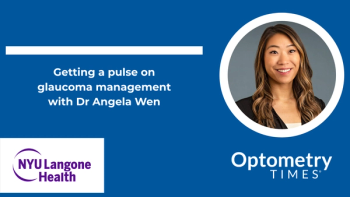
- November digital edition 2023
- Volume 15
- Issue 11
- Pages: 6
The relationship between myopia and glaucoma
Myopia as a glaucoma risk factor, and high myopia as a potential glaucoma mimicker, can be quite the clinical headache
“Every myopic disc is a glaucomatous disc until proven otherwise.” That quote from my glaucoma professor and dear friend, Leo P. Semes, OD, FAAO, may be the only surviving optometric quote left in the scrambled collision of neurons known as my cerebrum. It’s a great one to hold on to, and it holds a greater amount of significance given that cases of myopia are poised to increase significantly over the next few decades.
One meta-analysis of 145 studies estimates that myopia, which affected 22% of individuals globally in 2000, will be present in 50% of the world’s population by 2050.1 This seems like quite a staggering statistic until you hone in on the developed countries in East Asia, where the prevalence of myopia in school-aged children is 80% to 90%.2
Myopia—particularly axial myopia—carries a greater risk of glaucoma. I had a comically difficult time once trying to explain this concept to a lawmaker. Myopia control is not just treating individuals with blurry, uncorrected vision, and it’s not just individuals in undeveloped or underdeveloped countries walking around myopic because they have limited or no access to eye care and glasses. Myopia control is a public health issue that will continue to affect every country on the planet regardless of its socioeconomic status. Retinal pathology and glaucoma incidence will increase with increasing myopia worldwide, and as the –6.50 myopic author of this column stares at his computer through his floaters, he is aware of these implications.
So why does such a relationship exist between myopia and glaucoma? We simply don’t yet have the full picture. Longer eyes—such as those with axial myopia—tend to have relatively thinner scleras, and this may
lead to lamina cribrosas, which do not protect the fibers of the optic nerve from the shear stresses to which they are susceptible as they exit the globe.3 These retinal nerve fibers may be subject to distention as myopia increases. Further, beta-zone parapapillary atrophy, a well-established biomarker in glaucoma, tends to increase with increasing amounts of axial myopia. Spectral domain optical coherence tomography studies of highly myopic eyes do not fit as well into the normative databases as do lower and nonmyopic eyes.
Such variables can present a clinical quandary in the arena of glaucoma diagnosis and progression, but that quandary is not limited to the structural aspects of glaucoma because highly myopic patients can also have visual field defects that may mimic glaucomatous visual field defects.3 These visual field defects are not limited to enlarged blind spots, and they may include nasal step defects. There exists a real potential to misdiagnose a highly myopic patient with a nonprogressive visual field defect as having glaucoma. Such a misdiagnosis carries the propensity of costing the health care system considerable money and resources over a patient’s lifetime.
Why am I standing on the myopia control soapbox? It’s due to a conversation I had with a patient. He is a high myope with a spherical equivalent of approximately –12.50 in each eye, and he has Stickler syndrome, a hereditary progressive arthro-ophthalmopathy in which patients have a greater risk of high myopia and retinal holes and detachments. I follow him closely to check for glaucoma; his IOPs tend to be in the low 20s. So far, he has shown no signs of glaucoma. He has a family history of glaucoma on his mother’s side. None of his siblings have glaucoma. He also has a child who is 6 years old. I check her with comprehensive eye examinations annually, and she does not yet have myopia. I have discussed myopia control with this patient if his daughter becomes myopic, and he is receptive. During our conversation, he chuckled and said, “It would be great if she didn’t need glasses and didn’t have to come to see you every 6 months.” I laughed and said, “Yes, it would be good for her eye health, as well,” before explaining the pathology that can follow myopes around. When I explain these aspects of myopia to a patient, I use words such as “we” and “us” to remind the patient that I’m right there with them. I would appreciate that as a patient.
The notion of myopia as a risk factor for glaucoma coupled with high myopia as a potential mimicker of glaucoma gives me a clinical headache. It also supports why we should all be embracing myopia control. If you’re seeing a pediatric patient population and are not practicing myopia control, please develop a consultative relationship with a provider who does.
References
1. Holden BA, Fricke TR, Wilson DA, et al. Global prevalence of
myopia and high myopia and temporal trends from 2000 through
2050. Ophthalmology. 2016;123(5):1036-1042. doi:10.1016/j.
ophtha.2016.01.006
2. Lin LLK, Shih YF, Hsiao CK, Chen CJ. Prevalence of myopia in
Taiwanese schoolchildren: 1983 to 2000. Ann Acad Med Singap.
2004;33(1):27-33.
3. Sun MT, Tran M, Singh K, Chang R, Wang H, Sun Y. Glaucoma
and myopia: diagnostic challenges. Biomolecules. 2023;13(3):562.
doi:10.3390/biom13030562
Articles in this issue
almost 2 years ago
Harnessing digital media for enhanced patient engagement and outcomesalmost 2 years ago
Keep your contact lens practice on the cutting edgealmost 2 years ago
Distinguishing between dry eye and MGD: Believe your own eyesalmost 2 years ago
Separating the business of optometry from the desire to help patientsabout 2 years ago
The lowdown on hypoglycemia in patients with diabetesabout 2 years ago
Presbyopia and cataracts: Dysfunctional lens syndromeNewsletter
Want more insights like this? Subscribe to Optometry Times and get clinical pearls and practice tips delivered straight to your inbox.



















































.png)


